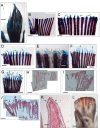Regeneration of the caudal fin of the evolutionary ancient tropical gar Atractosteus tropicus
- PMID: 39390615
- PMCID: PMC11465863
- DOI: 10.1186/s40850-024-00214-y
Regeneration of the caudal fin of the evolutionary ancient tropical gar Atractosteus tropicus
Abstract
Background: The tropical gar (Atractosteus tropicus), a member of the Lepisosteidae family, is native to regions extending from southeastern Mexico to southern Costa Rica. This species serves as a unique bridge between tetrapods and teleosts due to its phylogenetic position, slow evolutionary rate, dense genetic map, gene similarities with humans, and ease of laboratory cultivation. As a taxonomic sister group to teleosts like the zebrafish (Danio rerio), known for its high regenerative capacity, it remains unclear whether the tropical gar shares a similar ability for regeneration.
Results: This study aims to elucidate the caudal fin regeneration process in tropical gar through skeletal and histological staining methods. Juvenile specimens were observed over a two-month period, during which they were fed brine shrimp, and anesthetized with 1% eugenol for caudal fin amputation. Samples were collected at various days post-amputation (dpa). Alcian blue and alizarin red staining were used to highlight skeletal regeneration, particularly the formation of new cartilage, while histological staining with hematoxylin and eosin was performed to observe tissue regeneration at the amputation site.
Conclusions: The findings reveal a remarkable ability for caudal fin regeneration in juvenile tropical gar. Given the Garfish evolutionary relationship with teleosts, this opens new avenues for research into tissue regeneration across different groups of Actinopterygii.
Keywords: Caudal fin regeneration; EvoDevo; Garfish; Tropical gar.
© 2024. The Author(s).
Conflict of interest statement
The authors declare no competing interests.
Figures





References
-
- Wiley EO. The phylogeny and biogreography of fossil and recent Gars (Actinopterygii: Lepisosteidae). Misc. Publ Univ Kans Nat Hist Mus. 1976;64:1–111.
-
- Márquez-Couturier G, Vázquez-Navarrete CJ. (s.f.) Estado de arte de la biología y cultivo de pejelagarto (Atractosteus tropicus) AP AGRO Productividad. Vol. 8 Núm. 3 2015: Mayo-Junio.
-
- Instituto Mexicano de Investigación en Pesca y Acuacultura Sustentable. Subdelegaciones de Pesca-SAGARPA. Pejelagarto, distribución geográfica 2024. https://www.gob.mx/imipas/acciones-y-programas/acuacultura-pejelagarto
-
- Bussing W. Peces De las aguas continentales de Costa Rica. San José, Costa Rica: Editorial UCR; 2002.
-
- Espinosa-Perez H, Gaspar-Dilanar M, Fuentes-Mata P. Listados faunísticos de México III. Los peces dulceacuícolas mexicanos. México, D.F. Instituto De Biologia. Universidad Nacional Autónoma de México; 1993. p. 98.
Grants and funding
LinkOut - more resources
Full Text Sources
Research Materials

